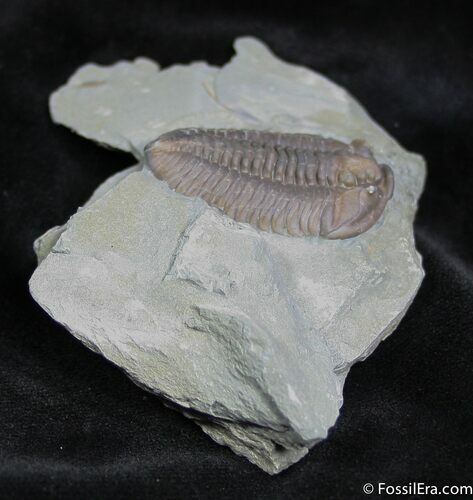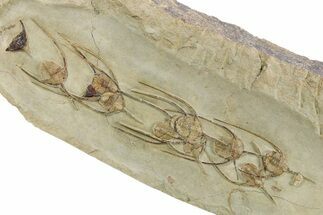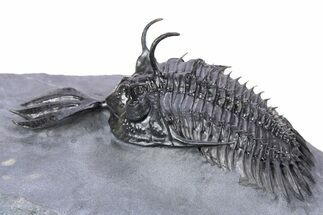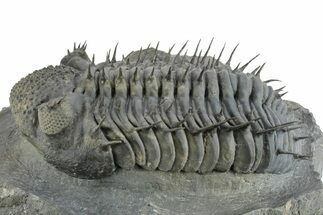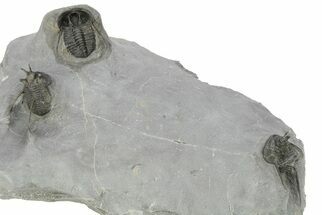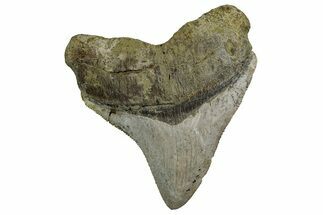This Specimen has been sold.
Twitter Contest Prize: 1.5 Inch Flexicalymene Trilobite
Win This Trilobite!
To help celebrate #FossilFriday we are running a series of fossil giveaways on our various social media accounts (Facebook, Twitter, Google+ and Pinterest). This is the prize for today's Twitter contest that will run for 24 hours from noon (PST) on Friday.
To enter all you have to do is (re)tweet) this page on Twitter and making sure to include @fossilera in the tweet. After the contests ends in 24 hours we will randomly select a winner from those that retweeted it and contact them via Twitter. You can reply to us on Twitter if you have any questions.
Be sure to follow @fossilera on Twitter if you haven't yet, as we will be regularly running contests, special offers as well as providing updates on new listings.
Other #FossilFriday Contests
We're running similar contests on Facebook, Google+ and Pinterest concurrently so check them out also.
Megalodon Tooth For Facebook
Fossil Fish For Google+
Fossil Ammonite For Pinterest
Now About The Trilobite
The trilobite is a large Flexicalymene retorsa which I collected myself this summer in Oldenburg, Indiana. It's 1 1/2 inches long, three dimensional, and has been microscopically prepared using air abrasives to reveal the surface detail.
To help celebrate #FossilFriday we are running a series of fossil giveaways on our various social media accounts (Facebook, Twitter, Google+ and Pinterest). This is the prize for today's Twitter contest that will run for 24 hours from noon (PST) on Friday.
To enter all you have to do is (re)tweet) this page on Twitter and making sure to include @fossilera in the tweet. After the contests ends in 24 hours we will randomly select a winner from those that retweeted it and contact them via Twitter. You can reply to us on Twitter if you have any questions.
Be sure to follow @fossilera on Twitter if you haven't yet, as we will be regularly running contests, special offers as well as providing updates on new listings.
Other #FossilFriday Contests
We're running similar contests on Facebook, Google+ and Pinterest concurrently so check them out also.
Now About The Trilobite
The trilobite is a large Flexicalymene retorsa which I collected myself this summer in Oldenburg, Indiana. It's 1 1/2 inches long, three dimensional, and has been microscopically prepared using air abrasives to reveal the surface detail.
About Flexicalymene Trilobites
Flexicalymene is a genus of trilobites of the order Phacopida, suborder Calymenina. These ancient arthropods are an index fossil of the Ordovician, between 488-443 million years ago. The graceful articulation, especially of the thorax segments, demonstrates that this distant precursor of insects is deserving of its delightful name.
Flexicalymene is often found enrolled, seemingly to protect its softer underside from threats on a sea floor teeming with ancient life and increasingly complex predators. Sealing itself inside the hard carapace may be a protective maneuver, or it may simply be the pose of death.
Two species of Flexicalymene are found in the Richmond Formation of Ohio, but in different sub-units. Flexicalymene meeki has small genal spines and is the more common of the two, often coming from Mt Orab, Ohio. These spines are absent in the other species, F. retrorsa. The F. retrorsa cephalon is more rounded, while the F. meeki cephalon is pronounced. They were also denizens at different locales. Calymene, meaning “beautiful crescent”, should not be confused with Flexicalymene: it is a separate genus.
Flexicalymene meeki has been studied for its abundant perforations. The perforations have been interpreted as the loci of sensory hairs: these loci occur in many sizes, and are an interesting feature of exoskeleton microfeatures. They are concentrated on areas most likely to contact other objects in the environment.
Flexicalymene is a genus of trilobites of the order Phacopida, suborder Calymenina. These ancient arthropods are an index fossil of the Ordovician, between 488-443 million years ago. The graceful articulation, especially of the thorax segments, demonstrates that this distant precursor of insects is deserving of its delightful name.
Flexicalymene is often found enrolled, seemingly to protect its softer underside from threats on a sea floor teeming with ancient life and increasingly complex predators. Sealing itself inside the hard carapace may be a protective maneuver, or it may simply be the pose of death.
Two species of Flexicalymene are found in the Richmond Formation of Ohio, but in different sub-units. Flexicalymene meeki has small genal spines and is the more common of the two, often coming from Mt Orab, Ohio. These spines are absent in the other species, F. retrorsa. The F. retrorsa cephalon is more rounded, while the F. meeki cephalon is pronounced. They were also denizens at different locales. Calymene, meaning “beautiful crescent”, should not be confused with Flexicalymene: it is a separate genus.
Flexicalymene meeki has been studied for its abundant perforations. The perforations have been interpreted as the loci of sensory hairs: these loci occur in many sizes, and are an interesting feature of exoskeleton microfeatures. They are concentrated on areas most likely to contact other objects in the environment.
SPECIES
Flexicalymene retrorsa
AGE
LOCATION
Oldenburg, Indiana
FORMATION
Fort Ancient Formation
SIZE
1.47"
CATEGORY
SUB CATEGORY
ITEM
#915
We guarantee the authenticity of all of our specimens.
 Reviews
Reviews




